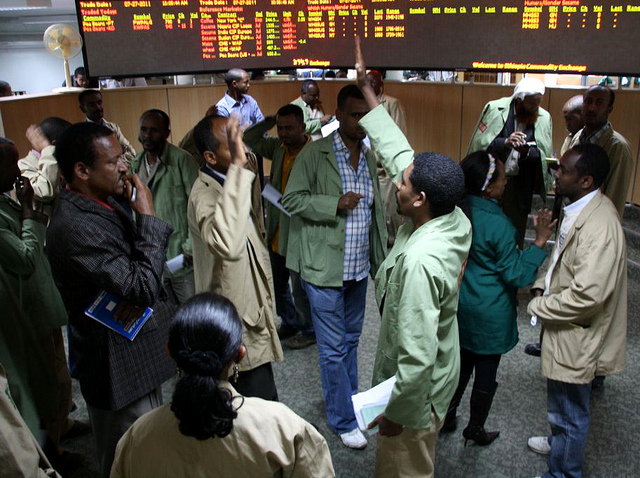As the only functioning commodity exchange in the Least Developed Countries (LDCs), the Ethiopia Commodity Exchange (ECX) is viewed as wildly successful in modernizing the that country’s economy, linking smallholder farmers to markets, and enhancing food security. Success stories, such as the claim that the ECX has effectively linked 2.4 million smallholder farmers to markets through agricultural cooperatives, have been heavily covered in both regional and global media outlets. However, according to a new study by IFPRI researchers Manuel Hernandez, Shahidur Rashid, and Solomon Lemma, and Tadesse Kuma of the Ethiopian Development Research Institute, the evidence behind such success stories has been largely anecdotal; there has been very little systematic analysis to determine whether the ECX is in fact the driving factor of improvements in Ethiopia’s agricultural markets.
“Market Institutions and Price Relationships: The Case of Coffee in the Ethiopian Commodity Exchange,” recently published in the American Journal of Agricultural Economics, looks specifically at international-domestic price relationships across the coffee value chain. Coffee is an important cash crop in Ethiopia, accounting for 35 percent of the country’s total export revenues between 2000 and 2014. In addition, more than 4.2 million smallholder farmers produce coffee beans, making the crop equally important to poverty alleviation efforts. When the ECX first began trading coffee in December 2008, the government suspended the country’s traditional coffee auction floor and made it mandatory for all coffee trading to be conducted through the exchange. This was done to ensure that the ECX received large enough market shares to make it successful on the coffee export market. Ethiopia’s coffee farmers are now required to sell their coffee at designated primary markets where only certified buyers are allowed to make purchases; similarly, coffee processors must receive approval to use designated warehouses, where their product is graded for either export or sale on the domestic market.
The study examines whether the establishment of the ECX and the regulatory supports to it have strengthened the price relationships between domestic markets in Ethiopia and the international market. The authors hypothesize that any institutional or regulatory intervention in a commodity market should be reflected in the price dynamics of that commodity. Thus, if the ECX has been effective in improving price discovery along the coffee value chain, this should be reflected through stronger international-domestic price relationships.
To test this hypothesis, the authors look at both the interdependence and the volatility transmission of prices across international and domestic markets from January 1992 through June 2013. The study focuses on five major coffee varieties and looks at prices at three levels: Farm-gate prices, auction prices (from the old auction floor until 2008 and from the ECX thereafter), and the international commodity price.
While the findings vary somewhat among different varieties of coffee beans, in general they show that the ECX has had a limited impact on the international-domestic price dynamics in Ethiopia’s coffee. Producer prices did see a general increase since 2008; however, only two out of five major coffee-producing regions saw increased interrelationships between auction and international prices. This suggests that while the relationship between local and international prices is generally significant, only a very small fraction of the movement of international prices (either increases or decreases) actually gets transmitted to producers.
The study also found that the ECX has had no significant impact on the spatial integration of coffee markets and that there has been no significant change in the extent to which price volatility gets transmitted from international to domestic markets.
While the ECX’s overall apparent lack of impact on Ethiopia’s coffee market may seem surprising, the authors highlight several potential reasons. First, before the establishment of the ECX, Ethiopia had a fairly well-functioning coffee auction floor in Addis Ababa; it is likely that this centralized market location provided enough information to integrate domestic and international markets reasonably well. Second, the strict regulations that the ECX has introduced into the country’s coffee market have resulted in higher transaction costs. These costs could potentially cancel out the benefits of some of the ECX’s innovations, such as electronic payment systems. Finally, the Ethiopian coffee sector continues to face some inherent challenges that are not affected by the ECX—namely, weak infrastructure and low productivity—and that also play an important role in the price relationships between markets. Even if the ECX functioned perfectly, these challenges would still exist and hamper improvements to market integration.
The authors acknowledge that since the ECX is a relatively new institution, the jury is still out on its ultimate effectiveness. However, they stress that donors, the Ethiopian government, and any other governments that may look to replicate the ECX in their own countries need to conduct more rigorous assessments of the ECX’s policies to ensure that they are in fact helping the smallholder farmers they intend to reach.
Sara Gustafson is a Communications Specialist and Manuel Hernandez a Research Fellow with IFPRI’s Markets, Trade and Institutions Division. A version of this post first appeared on the IFPRI Food Security Portal blog.







